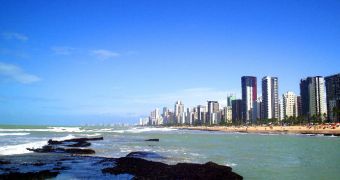The Heron Island Research Station, a research facility operated by the University of Queensland, is now the home of a state-of-the-art climate change experimental facility dedicated to understanding the effects that global warming has on oceans in general, and on coral reefs in particular.
The new facility was built as a part of the Climate Change Mesocosm (CCM) project. The endeavor is led by a team of experts from the Global Change Institute's Coral Reef Ecosystems Laboratory (CREI).
UQ associate professor Sophie Dove and CREI expert Dr. David Kline are the CCM project leaders. They say that the new research center is the most accurately controlled facility of its type in the world.
It provides the latest technology in ocean acidification and warming experimental systems, which will enable climate scientists to analyze some of the most complex and intricate phenomena affecting the world's ocean today in more detail than ever before.
Experts will also be able to simulates ocean temperatures and acidification levels that current climate models predict will be characterize the seas in 50 or 100 years from now.
But perhaps the most important thing is that scientists who will work here will be able to analyze all aspects related to climate change, down from the molecular to the ecosystemic level.
In addition to controlling temperatures, the facility can also provide complete control on carbon dioxide (CO2) levels. This will enable the accurate simulation of the 2100 IPCC scenarios.
“While similar to the 'Free Ocean Carbon Enrichment' (FOCE) project, recently featured in Sir David Attenborough's documentary 'Death of the Oceans,' the CCM differs in that it regulates the temperature, in addition to, the acidification levels above and below the current ambient conditions of water on the reef,” Dr Dove explains.
“It is unique in so far as the experimental controls allow variation with respect to real-time conditions of CO2 and temperature measured in the adjacent deepwater of Wistari channel,” she adds.
The facility contains 72 experimental aquariums, as well as 12 mini-reefs, so that investigators can see how corals respond to change. Day/night and seasonal variability can also be included in the research, which is something that few research centers have done before.
“We are simulating preindustrial ocean conditions of -100 ppm CO2 and minus 1°C; a control treatment of current reef CO2 and temperature; the 'B1' IPCC scenario of + 220ppm CO2 and +2°C, and an extreme "A1FI" scenario of +640 ppm CO2, +4.5 °C,” says Kline.
“In the eight months the FOCE system has been on the reef flat we have noticed the corals exposed to the higher CO2 levels look quite different,” he adds.
“The types of algae are different and the growth rate of the coral appears to have slowed. We expect to see similar results from the CCM experiments where reefal organisms respond to the dual influences of acidification and temperature,” concludes Kline, a GCI research fellow.

 14 DAY TRIAL //
14 DAY TRIAL //